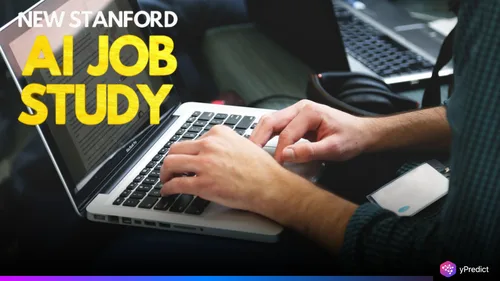
Artificial Intelligence has emerged as the biggest disruptor of the modern workforce. While it brings innovation and efficiency, it also threatens career pathways for young professionals. A new Stanford study has shed light on a concerning trend in the AI job market. According to the research, early-career workers, especially those aged 22 to 25, are experiencing significant job losses in AI-exposed occupations.
This shift in work patterns is not short-term obstacle but a structural change. The data demonstrated a 13% drop in work employment for young professionals in jobs that are susceptible to . These are not simply outliers, but an unmistakable example of how the job market is evolving. The promise of entry-level tech jobs with stability is waning for many graduates entering the workforce.
The data has generated a very lively discussion in the business, education, and political lake. Young professionals are trying to find their way in a labor market that often favors machines as companies move forward adopting systems designed to push through costs and improve efficiency. The AI job market was supposed to be offer human potential and opportunity. It is now changing what early-career work looks like.
How AI Is Reshaping the Entry-Level Tech Landscape
The report illustrates a clear division between occupations that AI can automate, and occupations that AI simply assists. Jobs requiring repetitive coding, data entry, and processing, and straight-forward analysis are the most vulnerable to AI. In these instances, AI is faster and cheaper than human labor leading to employers hiring fewer entry-level employees.
Conversely, jobs based on creativity and strategic decision-making, or human judgement are much safer from AI astonishments. The distinction means that some jobs are being replaced, while others jobs are being reimagined. Within elementary tech jobs, the hurdle relates to this unknown balancing act. Young professionals entering work-places tend to lack experience and the advanced skills that provide a buffer against automation, which makes them the first to feel the pinch of AI.
Why Early-Career Workers Are Hit the Hardest
Young professionals face tough challenges in today’s AI job market. Companies treat entry-level hires as replaceable and cut them first. The rise of AI tools makes managers expect quick results, so they invest less in training new workers. Many firms no longer see entry-level employees as worth the same training they once offered.
This shift hurts recent graduates the most. Entry-level tech jobs once opened doors into the industry. Without these roles, newcomers struggle to gain experience and build long careers. The Stanford study warns this trend may cause long-term skill gaps. Fewer trained workers today could mean fewer industry leaders tomorrow.
The Bigger Picture: What This Means for the Workforce
The shrinking of entry-level tech jobs is not only a youth problem; it’s a workforce-wide problem. As AI adoption speeds up, the job market is at risk of becoming polarized. There will always be demand for more highly skilled workers who design, manage, and fine-tune AI systems, while those at the lower end of the skills ladder become less and less relevant.
For the AI job market to be sustainable, companies and policymakers need to address the barriers that prevent young professionals from entering the workforce. Reskilling programs, apprenticeships, and educational reforms can help. By upskilling new workers, we want our workforce to adapt to automation rather than merely being displaced by it.
Future Pathways for Young Professionals
The Stanford findings are both a shot warning and a shot call to action. While AI will automate some current jobs, and then a reprieve in its the creation of opportunity in areas like AI ethics, system design, data strategy and cyber security, it will continue to evolve the job landscape. For young professionals to flourish in the new AI-centric job market, they need to pivot sooner than later and focus acquiring needed skills.
For organizations of higher education and training to flourish, they need to adapt their curriculum to support students’ shift into careers that will not easily be replaced with AI. Employers need to be patently aware of our obligation to invest in young professionals and not abandon them in the AI economy.
Final Thougts
The Stanford paper underscores a significant evolution in the AI job market. The entry-level tech job ecosystem, which has traditionally provided a path to a career, is shrinking due in no small part to automation. The young professionals it affects directly are feeling the greatest effects, but the change is broad in its repercussions across the entirety of the workforce. The challenge now becomes ensuring we align educational, business, and policy goals to find opportunity, rather than exclusion, for the next generation in the age of artificial intelligence.






